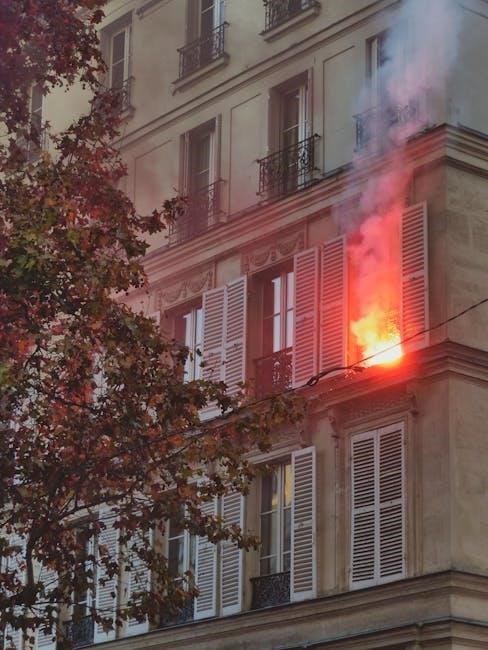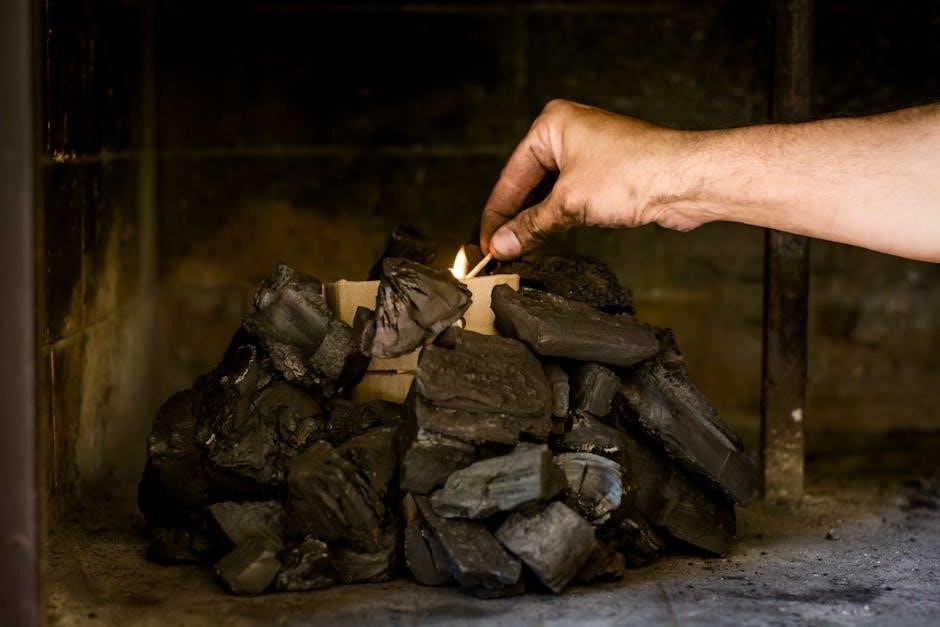Welcome to the Firex Smoke Alarm Manual, your guide to understanding and installing smoke alarms for enhanced home safety. This manual provides essential information on features, installation, and maintenance to ensure optimal performance and compliance with safety standards.
1;1 Overview of Firex Smoke Alarms
Firex smoke alarms are designed to provide reliable fire detection, utilizing ionization technology for accurate smoke sensing. They operate on 120V AC power with a 9V battery backup, ensuring continuous protection during power outages. These alarms feature Hush Mode to reduce false alarms and can interconnect with up to 18 compatible devices. UL-listed and designed for home safety, Firex alarms offer a test button for functionality checks and LED indicators for status updates, ensuring user confidence in their performance.
1.2 Importance of Reading the Manual
Reading the Firex Smoke Alarm manual is crucial for proper installation, operation, and maintenance. It provides essential safety information, feature details, and troubleshooting tips. Understanding the manual ensures correct usage, helping you respond appropriately during emergencies. It also highlights maintenance schedules and ways to prevent false alarms, ensuring your smoke alarm functions reliably for years. Take time to review the manual thoroughly to maximize safety and device performance.
1.3 Safety Precautions and Warnings
Always follow the guidelines outlined in the Firex Smoke Alarm Manual to ensure safe installation and operation. Avoid painting or covering the alarm, as this can impair its functionality. Install smoke alarms away from vents and direct sunlight to prevent false triggers. Keep the device out of children’s reach and ensure proper power connections. Failure to adhere to these precautions may void the warranty or reduce the alarm’s effectiveness. Regular maintenance is essential for reliable performance.

Key Features of Firex Smoke Alarms
Firex Smoke Alarms are designed with advanced features for reliable fire detection. They utilize ionization technology to detect smoke particles effectively. The alarms operate on 120V AC power with a 9V battery backup, ensuring continuous operation during power outages. Multiple units can be interconnected to provide whole-house protection. A hush mode reduces false alarms caused by cooking or steam. Additionally, a test button allows users to verify the alarm’s functionality, ensuring it works when needed most. These features combine to offer enhanced safety and reliability.
2.1 Ionization Technology for Smoke Detection
Firex Smoke Alarms employ ionization technology to detect smoke particles. This technology uses a small ionization chamber to monitor air quality. When smoke enters the chamber, it disrupts the ion flow, triggering the alarm. Ionization sensors are highly effective at detecting fast-flaming fires and are often more responsive to invisible particles. This makes them ideal for early detection of potentially dangerous fire conditions, ensuring timely alerts for improved safety and peace of mind.
2.2 120V AC Power with 9V Battery Backup
The Firex Smoke Alarm operates on 120V AC power, providing reliable performance, and includes a 9V battery backup for continuous protection during power outages. This dual-power system ensures uninterrupted monitoring, enhancing safety and compliance with fire safety standards. The battery backup activates automatically when AC power is lost, maintaining alarm functionality and providing peace of mind. This feature is essential for ensuring the alarm remains operational in emergency situations, even without mains power.
2.3 Interconnectivity with Other Firex Alarms
Firex Smoke Alarms can interconnect with up to 18 compatible devices, including smoke and heat alarms, ensuring a unified response to potential threats. This feature allows all alarms to sound simultaneously when smoke is detected, providing early warning throughout the home. Interconnectivity is achieved through a dedicated connector, ensuring reliable communication between devices. This system enhances safety by synchronizing alerts, helping occupants evacuate quickly and safely in the event of a fire. Proper installation and compatibility are crucial for optimal performance.
2.4 Hush Mode for Reducing False Alarms
The Firex Smoke Alarm features a Hush Mode designed to temporarily silence nuisance alarms caused by cooking smoke or steam. Activating this mode by pressing the test button stops the alarm sound while still maintaining detection capabilities. The red LED blinks every 2 seconds to indicate Hush Mode is active. This feature prevents unnecessary disruptions without compromising safety, allowing the alarm to resume normal operation after the air clears or the mode is deactivated. Regular testing ensures functionality remains reliable.
2.5 Test and Hush Button Functionality
The Firex Smoke Alarm includes a Test and Hush Button that serves dual purposes. Pressing the button tests the alarm’s functionality, ensuring it operates correctly. During a nuisance alarm, the same button activates Hush Mode, temporarily silencing the alarm. The red LED indicates active Hush Mode, blinking every 2 seconds. This feature enhances user convenience while maintaining safety by allowing quick resolution of false alarms without disabling the device entirely. Regular testing is crucial to ensure reliability.

Installation and Setup
Install your Firex Smoke Alarm on a wall or ceiling, ensuring it’s at least 10 feet from cooking appliances. Use the provided mounting bracket for secure placement. Insert the battery, connect the wiring if necessary, and test the alarm post-installation. Proper setup ensures reliable performance and early fire detection. Follow manual instructions for interconnected systems.
3.1 Recommended Locations for Smoke Alarms
Install smoke alarms inside every bedroom, outside sleeping areas, and on each level of your home. Place them on walls or ceilings, at least 10 feet away from cooking appliances to minimize false alarms. Avoid areas near bathrooms or kitchens where steam or smoke may trigger unnecessary alerts. Ensure alarms are interconnected for whole-house coverage and optimal fire detection. Proper placement enhances safety and complies with fire safety standards.
3.2 Locations to Avoid for Smoke Alarms
Avoid installing smoke alarms near bathrooms, kitchens, or laundry areas where steam or cooking fumes may cause false alarms. Do not place alarms near drafty windows, doors, or vents, as this can reduce their effectiveness. Keep alarms at least 10 feet away from cooking appliances and avoid areas with extreme temperatures or humidity. Never install alarms in garages, attics, or crawl spaces. Proper placement ensures reliable detection and minimizes nuisance alerts.
3.3 Step-by-Step Installation Guide
Choose a location that meets Firex recommendations, avoiding areas prone to false alarms.
Prepare the smoke alarm by removing it from packaging and inserting the battery.
Mount the bracket on the ceiling or wall using screws provided.
Attach the smoke alarm to the bracket and secure it firmly.
Connect to AC power if required, ensuring proper wiring.
Test the alarm using the test button to ensure functionality.
Clean the alarm to remove dust or debris.
Refer to the manual for interconnectivity setup if needed.
3.4 Interconnecting Multiple Smoke Alarms
To interconnect Firex smoke alarms, ensure all units are compatible and follow the manual’s instructions. Connect the wiring harness to the designated terminals on each alarm. Test interconnectivity by triggering one alarm to verify all connected units respond. Refer to the manual for specific wiring diagrams and maximum device limits. Proper interconnection ensures a unified safety system for your home. Always follow manufacturer guidelines for installation and testing.

Operation and Functionality
Understand how Firex smoke alarms detect smoke through ionization technology, utilizing 120V AC power with a 9V battery backup. Features include Hush Mode to temporarily silence false alarms, ensuring reliable fire detection while minimizing disruptions.
4.1 How the Smoke Alarm Detects Smoke
The Firex smoke alarm detects smoke using ionization technology, which senses invisible particles in the air. A small chamber inside the alarm contains a tiny radioactive source that ionizes the air, creating a current. When smoke enters, it disrupts the ion current, triggering the alarm. The alarm sounds and LED indicators flash to alert occupants of potential danger, ensuring early detection and response to fire hazards.
4.2 Understanding Alarm Sounds and LEDs
The Firex smoke alarm uses distinct sounds and LED indicators to signal different conditions. A loud, continuous beep indicates a fire or smoke detection, while a single chirp every 30 seconds signals a low battery. The red LED flashes during alarms, blinks rapidly in Hush Mode, and pulses every 15 seconds to indicate alarm memory. These visual and auditory cues ensure clear communication of the alarm’s status, helping users respond appropriately to emergencies or maintenance needs.
4.3 Smoke Alarm Memory and Clearing
The Firex smoke alarm features memory retention, where the red LED blinks every 15 seconds after detecting smoke. This memory lasts up to 24 hours, allowing users to identify past incidents. To clear the memory, press and hold the Test/Hush button until the LED stops blinking. This functionality helps in monitoring and addressing potential fire risks effectively, ensuring the alarm resets properly after an event has passed and conditions are safe.
4.4 Hush Mode Activation and Deactivation
The Hush Mode on Firex smoke alarms temporarily silences nuisance alarms caused by cooking or steam. To activate, press the Test/Hush button once; the alarm will stop, and the red LED will blink every 2 seconds. Hush Mode automatically deactivates after 15 minutes or when smoke is detected again. This feature ensures false alarms are minimized without compromising safety, allowing for quick restoration of normal operation when conditions return to normal.
4.5 Nuisance Alarm Prevention Tips
To minimize nuisance alarms, avoid installing smoke alarms near kitchens, bathrooms, or laundry areas where steam or cooking fumes are present. Regularly clean the alarm to remove dust and debris. Use the Hush Mode feature to temporarily silence false alarms caused by cooking or steam. Ensure proper ventilation in areas prone to smoke or vapor buildup. Testing the alarm weekly helps maintain its sensitivity and reduces the likelihood of unnecessary activations, ensuring it remains reliable for actual emergencies.

Maintenance and Upkeep
Regularly clean the smoke alarm to remove dust and debris, ensuring proper function. Replace batteries annually and test the alarm weekly to maintain reliability and performance.
5.1 Cleaning the Smoke Alarm
Regular cleaning is crucial for maintaining your Firex Smoke Alarm’s performance. Use a soft brush or vacuum cleaner to gently remove dust and debris from the exterior and interior. Avoid using chemical cleaners, water, or paint, as these can damage the sensor. Cleaning ensures the alarm detects smoke accurately and reduces false alarms. Refer to the manual for detailed cleaning instructions to maintain optimal functionality and safety standards.
5.2 Replacing the Battery
To ensure your Firex Smoke Alarm functions reliably, replace the 9V battery annually or when the low-battery chirp sounds. Open the battery compartment located on the back of the unit. Remove the old battery and insert a new one, ensuring correct polarity. Close the compartment securely. Testing the alarm after replacement is recommended to confirm proper operation. Always use the battery type specified in the manual to maintain performance and safety standards.
5.3 Testing the Smoke Alarm
Regular testing ensures your Firex Smoke Alarm operates correctly. Press and hold the Test button until the alarm sounds. The red LED will flash, confirming the alarm is working. Test the unit monthly to verify both the alarm sound and LED functionality. This process ensures the detector and battery are functioning properly, providing reliable fire detection and keeping your home safe. Always follow the manual’s testing instructions for optimal performance.
5.4 Troubleshooting Common Issues
If your Firex Smoke Alarm chirps or beeps, check the battery or power connection. For false alarms, clean the unit to remove dust or debris. If the LED flashes rapidly, it may indicate a sensor issue. Refer to the manual for specific LED patterns and their meanings. Ensure the alarm is not expired and replace it if necessary. Regular maintenance and testing can prevent many common issues and ensure reliable performance.

Technical Specifications
The Firex Smoke Alarm operates on 120V AC power with a 9V battery backup, utilizing ionization technology for smoke detection and supporting interconnectivity with up to 18 devices.
6.1 Power Requirements and Backup
The Firex Smoke Alarm requires a 120V AC power supply for primary operation, with a 9V battery serving as a backup during power outages. This dual-power system ensures continuous protection, even when the main electricity fails. The alarm’s unique power connector prevents interconnection with incompatible devices, maintaining reliability and safety. Proper installation and maintenance of both power sources are crucial for optimal performance, as outlined in the manual.
6.2 Sensor Type and Detection Range
Firex Smoke Alarms utilize ionization technology for precise smoke detection. The sensor detects invisible smoke particles, ensuring early warning of potential fires. With a wide detection range, these alarms are highly effective in open spaces, providing reliable protection; The manual specifies optimal installation locations to maximize coverage and reduce false alarms, ensuring the sensor operates efficiently in various environments. Proper placement is key to maintaining accuracy and responsiveness.
6.3 Compatibility with Other Systems
Firex Smoke Alarms are designed to integrate seamlessly with other Firex and Kidde devices, ensuring a unified safety network. They support interconnectivity with up to 18 devices, including smoke and heat alarms, enhancing whole-home protection. Compatibility with existing systems ensures streamlined installation and operation, while maintaining reliability and performance. This feature-rich integration capability allows for comprehensive fire detection and alarm systems, tailored to various home configurations and safety needs.
6.4 Certifications and Compliance
Firex Smoke Alarms meet rigorous industry standards, ensuring reliability and safety. They are UL listed, complying with NFPA 72 standards, and designed to adhere to local fire safety regulations. These certifications guarantee that the alarms perform optimally in detecting smoke and alerting occupants. Compliance with these standards ensures that Firex Smoke Alarms provide trusted protection, meeting both regulatory requirements and homeowner expectations for effective fire detection and warning systems.

Safety Tips and Best Practices
Prioritize fire safety by testing alarms weekly and ensuring proper installation. Never paint smoke alarms or cover them with tape. Install alarms on every home level for comprehensive protection.
7.1 Ensuring Proper Smoke Alarm Coverage
Ensure smoke alarms are installed on every level of your home and inside each sleeping area. Install alarms in hallways outside bedrooms and in living areas. Avoid placing alarms near kitchens or bathrooms to reduce false alarms. Use interconnected alarms for whole-home coverage, ensuring all units sound if one detects smoke. This setup provides early warning, critical for escaping fires safely. Proper placement maximizes detection effectiveness and ensures compliance with safety standards.
7.2 Preventing False Alarms
To minimize false alarms, avoid installing smoke alarms near kitchens, bathrooms, or areas with high humidity. Regularly clean the alarm to remove dust and debris. Use the Hush Mode feature to temporarily silence nuisance alarms caused by cooking or steam. Ensure proper installation and avoid placing alarms near heating vents or drafty areas. This helps maintain reliability and reduces unnecessary alerts, ensuring your safety without interruptions.
7.3 Fire Safety Habits to Adopt
Develop a routine of testing your smoke alarm monthly using the test button. Replace batteries annually and ensure all family members know the alarm’s sound. Create an escape plan and practice it with household members. Store flammable materials safely and never disable alarms. Teach children the importance of alarms and establish a meeting point outside the home; These habits enhance fire preparedness and ensure swift action in emergencies.
7.4 Regular Maintenance Schedule
Perform monthly testing by pressing the test button and cleaning the alarm with a vacuum or soft brush. Replace batteries annually or as indicated by low-battery chirps. Check LED indicators regularly to ensure proper function. Inspect for dust or obstructions every six months and ensure all units are interconnected. Replace the alarm after 10 years or when it shows signs of wear. Keep the manual handy for detailed maintenance steps.

Troubleshooting Common Issues

This section addresses frequent concerns like alarm chirping, false alarms, and LED malfunctions. Follow step-by-step solutions to resolve issues and ensure your smoke alarm functions correctly.
8.1 Alarm Chirping or Beeping
Chirping or beeping from your Firex smoke alarm often indicates a low battery or power issue. Check the battery level and replace it if necessary. Ensure the alarm is properly connected to AC power. If the issue persists, clean the unit to remove dust or debris that may cause false alarms. Refer to the manual for specific troubleshooting steps tailored to your model. Addressing these issues promptly ensures continuous fire protection for your home.
8.2 False Alarms and Their Causes
False alarms on Firex smoke alarms are often triggered by cigarette smoke, cooking fumes, or steam. To minimize these occurrences, install alarms at least 10 feet away from kitchens and bathrooms. Regular cleaning of the unit and avoiding exposure to direct smoke sources can also reduce false alarms. Proper installation and maintenance as outlined in the manual ensure reliable performance and minimize unnecessary alerts.
8.3 LED Indications and What They Mean
The Firex smoke alarm uses LED indicators to signal its status. A red LED blinking every 15 seconds indicates alarm memory, showing a past smoke event. In Hush Mode, the red LED blinks every 2 seconds, active only on the initiating alarm. Pressing the test button clears the memory and stops the alarm pattern if no smoke is present. These visual cues help users understand the alarm’s status and necessary actions.
8.4 Interconnectivity Problems
Interconnectivity issues with Firex smoke alarms can occur due to incorrect wiring, incompatible models, or power supply problems. If alarms fail to interconnect, check wiring connections and ensure all units are compatible. Verify that the system is properly powered and that no damage exists to the interconnect wires. Refer to the manual for specific troubleshooting steps to resolve connectivity issues and ensure all alarms function as a unified system for maximum safety.
Proper installation, maintenance, and understanding of your Firex smoke alarm ensure enhanced home safety. Always follow the manual for optimal performance and to protect your family from fire hazards effectively.
9.1 Summary of Key Points
This manual provides comprehensive guidance on Firex smoke alarms, emphasizing proper installation, maintenance, and operation. Key points include optimal placement, regular testing, and battery checks to ensure reliability. Features like Hush Mode and interconnectivity enhance functionality. Always follow safety standards and manufacturer instructions to maximize protection. By adhering to these guidelines, you can ensure your Firex smoke alarm operates effectively, providing critical early warnings in case of fire hazards.
9.2 Final Safety Reminders
Never ignore the smoke alarm’s sound, as it signals potential danger. Regularly test the alarm and check battery levels to ensure functionality. Avoid painting or covering the device, as this can impair its performance. Do not disconnect the alarm during power outages, as it may lose critical backup power. Replace the alarm every 10 years or as specified by the manufacturer to maintain reliable protection for your home and family.

Additional Resources
Access the full Firex Smoke Alarm Manual online for detailed instructions. Contact Firex support for assistance and explore additional safety guides for comprehensive fire protection knowledge.
10.1 Downloading the Full Manual
To access the complete Firex Smoke Alarm Manual, visit the official Firex website or trusted platforms like ManualsLib. Search for your specific model, such as the i4618 or FADC series, and download the PDF guide. This resource provides detailed installation, operation, and troubleshooting instructions. Ensure you refer to the correct manual for your device to maximize safety and functionality. Reliable sources include Firex official support and authorized distributors like Safelincs.
10.2 Contacting Firex Support
For assistance with your Firex Smoke Alarm, contact Firex customer support via their official website or phone. Visit the “Contact Us” section for details. You can also reach out through email or live chat for troubleshooting or product inquiries. Ensure to have your model number ready for efficient support. Firex support is available to address installation, maintenance, or technical issues, providing expert guidance to ensure your smoke alarm operates effectively.
10.3 Finding Additional Safety Guides
For comprehensive safety, visit the Firex official website to access downloadable PDF manuals, technical specifications, and additional safety guides. These resources provide detailed insights into proper installation, maintenance, and troubleshooting. You can also explore safety tips and best practices from reputable fire safety organizations. Ensure to reference the latest editions for updated information and compliance with current safety standards. Regularly check for new guides to stay informed and enhance your home’s fire safety measures effectively.

